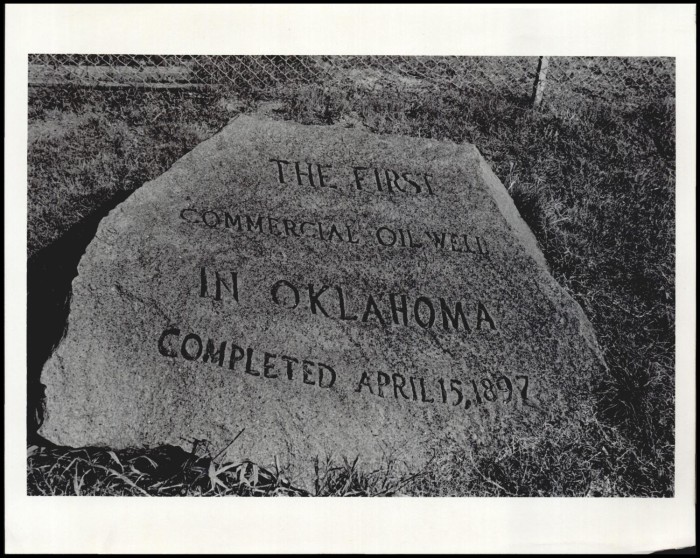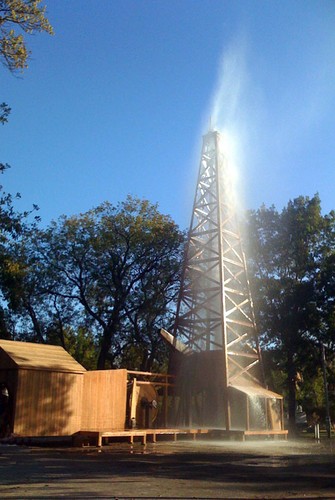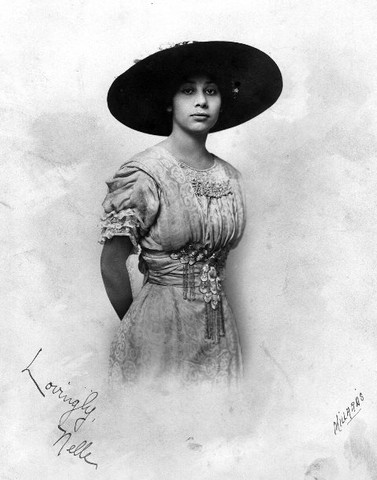Nellie Johnstone Number One Replica
Introduction
Text-to-speech Audio
This redwood replica of the oil well Nellie Johnstone Number One is located in Johnstone Park to commemorate the historical significance of April 15, 1897. On that day, the Nellie Johnstone became the first commercial oil well in Oklahoma, then known by the name Indian Territory. After a device known as a go-devil was dropped down the 1,300-foot well, a nitroglycerin charge sent oil rushing from below the surface and towered over the derrick. In retrospect, that explosion marked the beginning of Oklahoma’s oil boom. The well was located on land leased from the Cherokee Nation, who like other Native Americans in the region before, had been using crude oil seeps as medicine for decades. The commercial value of the Nellie Johnstone well led to additional wells and the arrival of businessmen such as Phillips Petroleum founder Frank Phillips in 1904. The influx of people and investment made Bartlesville one of the centers of oil production in the United States. Together with the influx of settlers following a series of land rushes that redistributed Native American lands, the railroad reached Bartlesville, another factor that proved essential to Oklahoma's oil boom in the early 20th century.
Images
Historical markers were placed by the well in the mid-twentieth century to mark its importance to the oil industry.

In 2008, water was used to reenact the Nellie Johnstone Number One's gusher.

The Nellie Johnstone Number One was set off at 3 p.m. on April 15, 1897.

The well was named after Nellie Johnstone, William Johnstone's Daughter.

Backstory and Context
Text-to-speech Audio
Indigenous People living in the area had utilized Indian Territory’s natural oil and gas seeps long before the arrival of white settlers. Native Americans who lived in the area before the nineteenth century, and those like the Cherokee and Chickasaw who were forcefully moved, used the Black liquid that they found beneath rocks and on top of streams as medicine for themselves and their animals. Numerous Native American agents reported seeps during the 1830s and even white outsiders utilized the crude material for health purposes, establishing spas at Maytubby Springs around Caddo and New Spring Place near Oaks, close to Oklahoma’s eastern border.
George B. Keeler, a merchant who moved to Indian Territory in 1871, first spotted oil on the south bank of the Caney River in 1875. Keeler lacked willing oil drilling partners for over twenty years, before convincing William Johnstone and Frank Overlees to join his project in the late 1890s. The men opened a trading post near the seep’s location, obtained a lease from the Cherokee Nation who owned the land, and hired Cudahy Oil to drill their well. During the winter of 1896-97, Cudahy drillers A.P. McBride and C.L. Broom hauled a rig that previously stood over a dry hole in Red Fork to Bartlesville, and by January, the team was ready to start drilling.
At 3 p.m. on April 15, 1897, Keeler’s stepdaughter Jennie dropped a torpedo down a well, setting off a nitroglycerin charge. Crude oil shot up the 1,300-foot shaft and into the air, towering over the wooden derrick that would now be called the Nellie Johnstone Number One, named for William Johnstone’s daughter. Soon however, the surplus of oil that was produced flooded local markets and drove down prices, causing the well to be capped until 1899. This year marked the arrival of the Kansas, Oklahoma Central, and Southwestern Railway to Bartlesville, which played a crucial role in the oil drilling process, as it provided the means to ship and sell the thousands of barrels produced a year to outside markets.
Oklahoma’s oil boom had begun. The success of the Nellie Johnstone led to exploration of other nearby areas, including the Osage lands to Bartlesville’s west, which would go on to become one of the most prosperous oil-producing regions in the world. The commercial opportunities that came with oil’s discovery also brought thousands of people to Indian Territory looking to get rich. This included L.E. and Frank Phillips, brothers who moved to Bartlesville in 1904 and would go on to start Phillips Petroleum Company.
The shooting of the Nellie Johnstone, the railroads arrival in 1899, and the Dawes Act of 1893, which opened this section of the Cherokee Nation to white settlement, meant that Bartlesville grew rapidly. The downtown district of the frontier town became the center of the oil industry in America, and Bartlesville’s legacy would be tied to oil for years to come. The Nellie Johnstone was permanently capped in 1948 after producing over 100,000 barrels of oil in just over fifty years. In 1953, with the original well faltering, a sturdier and faithful reproduction was built using redwood timbers. The site was listed on the National Register of Historic Places in 1972 and now sits in Johnstone Park, symbolizing one of the most famous rushes to riches chapters in American history.
Sources
"Bartlesville Downtown Historic District" National Register of Historic Places Nomination Form (Washington, DC: U.S. Department of the Interior, National Park Service).
Franks, Kenny A. Petroleum Industry, The Encyclopedia of Oklahoma History and Culture. Accessed May 2nd 2022. https://www.okhistory.org/publications/enc/entry.php?entryname=PETROLEUM%20INDUSTRY.
"Nellie Johnstone NO 1" National Register of Historic Places Nomination Form (Washington, DC: U.S. Department of the Interior, National Park Service). April 11, 1972.
Wilson, Linda D. Nellie Johnstone Number One, he Encyclopedia of Oklahoma History and Culture. Accessed May 2nd 2022. https://www.okhistory.org/publications/enc/entry.php?entry=NE003.
Oklahoma Historical Society
American Oil and Gas Historical Society
Oklahoma Historical Society
American Oil and Gas Historical Society
